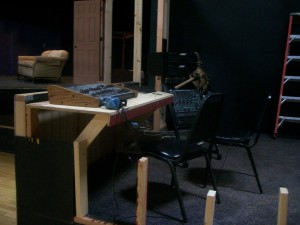One of the more entertaining aspects of being involved in the production of Inspecting Carol has been the chance to, in essence, watch ourselves at work. In the play, the managers of the fictitious Soapbox Theatre are trying to make ends meet as the actors and crew try to put on another run of A Christmas Carol. Zorah (played by Yvette Zapfael), the artistic director and theatre manager Kevin (Adam Hegg), fret about grants and selling out performances in a theatre that can barely keep the lights on. Stage manager MJ (Sarah Bixler) and technician Bart (Kevin Schilling) worry about getting the trap doors, fog machine, and lights to work long enough to rehearse and put on the play.

Cast of Inspecting Carol rehearses a scene as I a read manual on the theatre's audio software - Nov. 20, 2011
Their real counterparts in Burien Little Theatre certainly see ourselves in these characters. Artistic Director Eric Dickman and Theatre Director Maggie Larrick have to juggle budgets and work with the city of Burien to make sure that there is a place to put on shows and money to produce them. Stage manager Cyndi Baumgardner, stage crew members Gavin Doiron and Sandy Mize, and I, along with the cast, meanwhile have to work out how to put on the show. As the caption of the photograph shows, I had to learn how to run the audio computer software as I was entering the cues for the show. Cyndi had to learn how to run the light board, and Gavin and Sandy had to learn all the things they needed to do in order to make sure that the actors had their props and costumes, and were able to make their entrances. Gavin had to learn how to drop a stage platform on cue, and to run a balky fog machine.

From left, staqe manager Cyndi Baumgardner, director Maggie Larrick, and costume designer Amanda Winter discuss technical and staging issues to be worked out after the first tech rehearsal - Nov. 21, 2011
When you’re in an amateur theatre production, this is what being on a stage crew means.
For me, this has been an especially interesting production. I once again am working with Cyndi, who stage managed numerous BLT productions during the late 1980s and early 1990s. Since Inspecting Carol is set in about that same time, it’s been a bit like flashing back to that time. Of course, there are some differences.
As is only right in a show that features the ghosts of Christmas past and present, the past and the present of BLT are very much in evidence here.
Perhaps the most obvious difference is the nature of the sound and light equipment we now use here at BLT. Back in the early ’90s, computer control of sound and light cues was primarily a technology that only big theatres could afford. As can be seen in this photo of our old equipment, which we have been able to use as set dressing in this show, there are no computers here. The old light board was actually more advanced than the one I was using back in the old days, but it still must be operated manually. It is a two-scene preset model, which means that a light operator can set the light levels for the next cue while the current light levels are unaffected. Before we had that board, the board operator had to figure out how to move as many as a dozen sliders at once to their new positions for each cue.

Mr. Potato Head, BLT's tech booth mascot during the 1980s, relives the good old days in the Inspecting Carol booth set. Dec. 16, 2011
Now, with computerized light board, most cues require nothing more than for the operator to hit a single button at the right time. Running lights in a show has gone from being a learned skill to being something that a stage manager or crew member can do with a few minutes’ training.
Yet the light cues can be much more sophisticated. Cues can be set to follow one another automatically. They can be set to fade in or out at precise rates. Literally dozens of individual channels can be changed at once, with no more required of the operator than to push the “Go” button at the right moment.
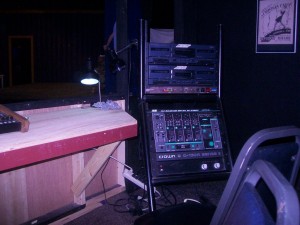
BLT's old sound equipment, a pair of cassette decks, mixer, and amplifier, now being used as set dressing for the booth in Inspecting Carol - Dec. 16, 2011
Sound has changed similarly, though in some ways we’ve replaced one source of complexity for another. Back in the 1990s, we used stacks of audio cassettes for most audio cues. While I never worked with these particular cassette decks, the equipment we were using back then was similar. When there was a cue that needed to be timed precisely, we needed to know how quickly a paused cassette tape would start playing when performing a cue.
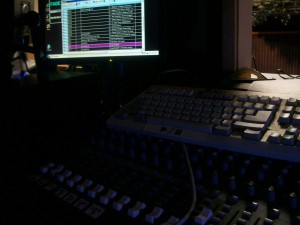
Some of BLT's current audio equipment, which includes a 24 channel audio mixer and a computer for playing sound cues. Dec. 16, 2011
Nowadays, the audio equipment looks considerably different. Here’s a view of our current system in the real booth. There is an audio mixer, the sort used in some recording studios and many presentation and performance halls, and a computer that plays most of the cues. We also have a CD player and a lovely MD deck, but we hardly ever use them anymore.
As with computerized light boards, computers with modern cue software can be used to have cues fade in and out at precise rates, to have other cues follow automatically, and to set levels or edit cues without changing the actual source material the cue came from.
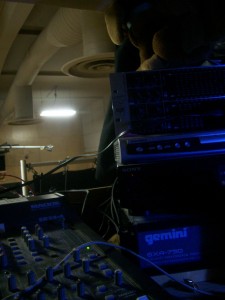
Sparky, BLT's new tech booth mascot, watches over the stage from his perch atop the audio stack. Dec. 16, 2011
In some ways, computers have made the job of running a show easier, as long as they operate correctly. The BLT sound computer is now used for nearly all cues, and as long as it works correctly the sound cues can be both sophisticated and timely.
Of course, the computer has given us a scare once or twice, acting as though it wouldn’t boot up, or seeming to lose all the data we’d carefully put on it for a show.
No change is entirely without disadvantages, and nowhere is that more true than in theatre.
One thing that hasn’t changed over the years is that a tech crew is composed of imaginative and smart people who often have too much time on their hands. One symptom of this is the seemingly endless doodles, carvings, and other examples of what idle minds do when they have to be in a particular place for a length of time.
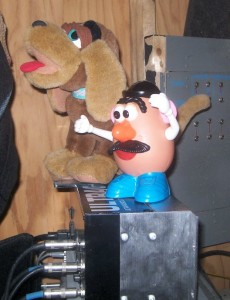
Mister Potato Head and Sparky, past and present BLT tech booth mascots, watch the show from the best seats in the house - Dec. 16, 2011
Another symptom is the long parade of mascots that have decorated the tech stations and booths over the years. Mr. Potato Head graced the booth back in the time when it was an open platform we rolled into place at the back of the auditorium. Since then, there have been any number of statues, dolls, and symbols, of which Sparky is only the latest. He joined us after last season’s production of Reefer Madness. In between there have been a number of other mascots that probably had meaning only to those who were working in the booth at the time – there’s an owl-ish looking thing, and a pair of horns, and stuff that I don’t even want to try to identify.
Technology comes and goes, and so do many of the people, but as this production of a play about doing a play reminds us, some things remain the same.

